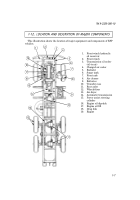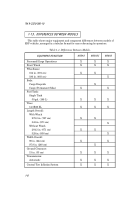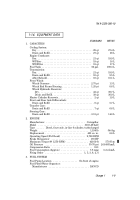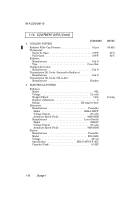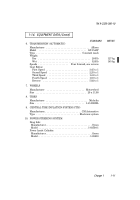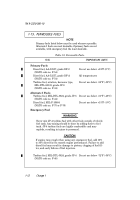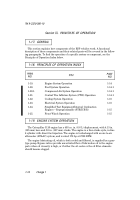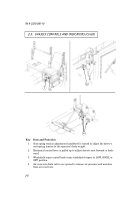TM-9-2320-386-10 - Page 33 of 223
TM 9-2320-386-10
Change 1
1-15/(1-16 blank)
The engine has a pressurized cooling system with a shunt line. The system can safely
operate at a temperature higher than the normal boiling point of water, which prevents
pitting and wear inside the water pump.
ESP vehicles have a 10-plate transmission oil cooler located in the radiator outlet
tank and an auxiliary oil cooler in front of the radiator. The oil coolers are designed to
keep the automatic transmission running at a safe operating temperature.
Major components of the cooling system are the radiator, charged air cooler, water
pump, surge tank, water thermostat regulator, fan, and fan actuator.
The ESP series electrical system operates similarly to the M44A2 series electrical
systems.
The STE/ICE-R system is a reprogrammable version of the STE/ICE system common-
ly used to test the serviceability of standard M44A2, 2-1/2-ton vehicles. When in opera-
tion, test data are transmitted from transducers to a permanently-mounted Diagnostic
Connector Assembly (DCA) located on the instrument panel on the passenger side of the
vehicle. The data are then transferred through a DCA cable to the Vehicle Test Meter
(VTM). The VTM uses the data received, and stored vehicle information, to give a result.
The STE/ICE-R can measure standard voltage, current, resistance, pressure, temper-
ature, and speed. Special tests, such as the compressor unbalance test and starter sys-
tem evaluations, are also performed by STE/ICE-R.
The ESP vehicle uses the same front winch commonly found on the M44A2 series
vehicles. The front winch is powered by a hydraulic system that transmits pressurized
fluid from an engine-driven pump to drive hydraulic winch motor attached to the rear of
the winch at the input shaft. The pump is driven by the engine and creates a vacuum
that draws oil from the reservoir to a bypass valve. When the winch is not engaged, the
bypass valve routes the oil, via the filter, back to the reservoir. To engage the winch, the
lower air valve lever on the shift tower is pulled out and up, and compressed air closes
the bypass valve reservoir return port and opens the control valve supply port. The con-
trol valve determines the direction of drum rotation by routing the oil in either a clock-
wise or counterclockwise direction through the hydraulic motor by engaging the upper
air valve lever on the control tower. The upper air valve uses compressed air to open
and close the ports on the control valve.
1-25. FRONT WINCH OPERATION
1-24. SIMPLIFIED TEST EQUIPMENT/INTERNAL COMBUSTION
ENGINES - REPROGRAMMABLE (STE/ICE-R)
1-23. ELECTRICAL SYSTEM OPERATION
1-22. COOLING SYSTEM OPERATION
Back to Top

